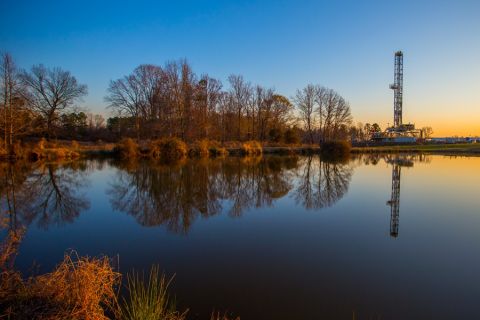
TULSA, Okla. -- Although the South Central Oklahoma Oil Province (SCOOP) – an extension of the liquids-rich Cana Woodford shale play – remains in its infancy, the area is yielding impressive results from early wells.
The Woodford shale play within the Big 4 formation has emerged as a major horizontal play in the SCOOP during the past four years. It’s a trend that shows no signs of letting up, according to Joe Schimelpfening, senior vice president, upstream business, Eagle Rock Energy Partners LP.
Speaking at Hart Energy’s DUG Midcontinent conference in Tulsa on April 23, Schimelpfening said the prolific oil targets in South Central Oklahoma will continue to see “strong industry development” in the horizontal Woodford play as well as the Bromides, Big 4, Springer and Deese horizons.
“The area is very special in ways not uncommon to other shale plays. It’s in a great neighborhood,” he told attendees.
The SCOOP stretches south in a 100-mile fairway from the Cana Woodford to the valley of the Red River, which separates Texas and Oklahoma. The fairway includes three of the top oil-producing counties in Oklahoma, which have combined to yield 3.2 billion barrels of oil from 60 reservoirs during the past 100 years, Schimelpfening said.
Bounded on the north by the Nemaha Uplift; on the south by the Wichita Uplift; and on the east by the Arbuckle Uplift, the siliceous Woodford shale known as SCOOP is as much as 15,000 feet deep and up to 400 feet thick.
What’s more, the SCOOP is surrounded by four prolific, giant oil fields – Sho-Vel-Tum, 1,700 million barrels of oil equivalent (MMBoe); Golden Trend, 1,020 MMBoe; Oklahoma City, 950 MMBoe; and Cement, 420 MMBoe.
“Horizontal Woodford drilling – immediately south of the Golden Trend field in particular – is delivering excellent early production results,” he said. “Additional horizontal targets are emerging in this oil-rich province targeting tight carbonate and sandstone reservoirs.”
The western half of Oklahoma lies on top of the Anadarko Basin, a huge sedimentary formation that has already yielded most of Oklahoma’s conventional oil and natural gas.
In 2012, attention turned to the possibility of unlocking the basin’s unconventional resources using the same horizontal drilling and hydraulic-fracturing techniques that have prized millions of barrels of oil and condensates from the Bakken in North Dakota and the Eagle Ford in South Texas. As a result, Woodford horizontal activity shifted to Grady and Garvin counties, and the most active operators in the area included Continental, Newfield, Marathon and Eagle Rock, according to Schimelpfening.
Continental Resources Inc. – the largest leaseholder in the nation’s premier oil play, the Bakken – called the Woodford shale “one of the thickest, best-quality resource shale reservoirs in the country.” During an October 2012 analyst presentation, the Oklahoma City-based producer revealed that it had blocked up 197,000 net acres in what it dubbed the SCOOP that Continental considered prospective for liquids-rich Woodford shale.
In 2011 and 2012, the focus was on delineating the play’s potential and holding acreage. According to Schimelpfening, 2013 activity has been concentrated on testing increased density (ID) patterns in Southeast Cana. He also noted the following:
- Cana (Canadian Co.) ID patterns range from 4 to 9 wells/section.
- Some well interference has been noted with the tighter spacing patterns.
- Two-section laterals are gaining momentum.
“Dual-section Woodford horizontal laterals in the more shallow areas and stacked horizontal laterals in the thicker Woodford sections will likely become more common in the play’s development,” he said. “The performance of various increased-density spacing configurations also will continue to be evaluated before the optimum recovery and economics are determined.”
Meanwhile, the industry’s “learning curve” for drilling and completion operations has continuously improved – perhaps the most important factor in sustaining the play during volatile commodity environments, Schimelpfening added.
“Additional reservoirs, both conventional and unconventional, must be continually evaluated within the SCOOP for their potential as horizontal targets,” he added.
Recommended Reading
EIA: Permian, Bakken Associated Gas Growth Pressures NatGas Producers
2024-04-18 - Near-record associated gas volumes from U.S. oil basins continue to put pressure on dry gas producers, which are curtailing output and cutting rigs.
Benchmark Closes Anadarko Deal, Hunts for More M&A
2024-04-17 - Benchmark Energy II closed a $145 million acquisition of western Anadarko Basin assets—and the company is hunting for more low-decline, mature assets to acquire.
‘Monster’ Gas: Aethon’s 16,000-foot Dive in Haynesville West
2024-04-09 - Aethon Energy’s COO described challenges in the far western Haynesville stepout, while other operators opened their books on the latest in the legacy Haynesville at Hart Energy’s DUG GAS+ Conference and Expo in Shreveport, Louisiana.
Mighty Midland Still Beckons Dealmakers
2024-04-05 - The Midland Basin is the center of U.S. oil drilling activity. But only those with the biggest balance sheets can afford to buy in the basin's core, following a historic consolidation trend.
Mesa III Reloads in Haynesville with Mineral, Royalty Acquisition
2024-04-03 - After Mesa II sold its Haynesville Shale portfolio to Franco-Nevada for $125 million late last year, Mesa Royalties III is jumping back into Louisiana and East Texas, as well as the Permian Basin.





